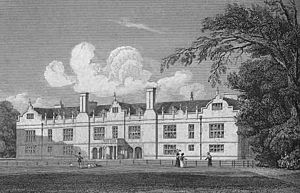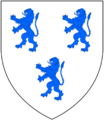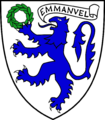Walter Mildmay facts for kids
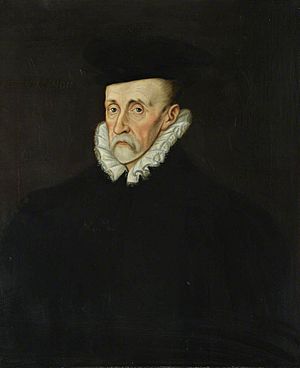
Sir Walter Mildmay (born before 1523 – died 31 May 1589) was an important statesman in England. He served as the Chancellor of the Exchequer for Queen Elizabeth I. This role meant he was in charge of the country's money. He also famously started Emmanuel College, Cambridge, a college at the University of Cambridge.
Contents
Early Life and Family
Walter Mildmay was born in a place called Moulsham in Essex, England. He was the youngest of four sons. His father, Thomas Mildmay, was an Auditor for King Henry VIII. An auditor checks financial records. Thomas Mildmay became very wealthy during the Dissolution of the Monasteries, when the King took over many religious buildings. In 1540, his father bought the large estate of Moulsham and built a grand house there.
A Busy Career in Government
Walter Mildmay studied at Christ's College, Cambridge. He then studied law at Gray's Inn in London. He started working for his father in the Court of Augmentations, which managed the King's new properties. Around 1545, he became one of the main surveyors for this court.
During King Edward VI's time, Mildmay's career grew.
- In 1547, he was made a knight.
- He helped create a list of the late King's belongings.
- He was asked to report on the Crown's income.
- He worked on selling lands and keeping grammar schools open.
Mildmay received many land grants for his hard work. He got land in Gloucestershire and Berkshire. He also got land in Oxfordshire, Northamptonshire, Cornwall, Essex, and London. His main home in the countryside was Apethorpe Palace in Northamptonshire. He bought it in 1552. When he was in London, he lived in the area of St Bartholomew-the-Great.
Financial Expert
Mildmay quickly became known as a skilled financial expert.
- In 1550, he helped check the accounts of the King's mints, where coins were made.
- In 1551, he helped set up a new mint in York.
- He was part of a group that checked the courts managing Crown lands.
- In 1552, he was asked to collect the King's debts.
- He also helped manage the money from dissolved monasteries.
Member of Parliament
Mildmay was elected to Parliament many times.
- He represented Lostwithiel in 1545.
- He represented Lewes in 1547.
- He represented Maldon in 1553.
- He represented Peterborough later in 1553.
Even though he was a strong Protestant, his career did not suffer much when Queen Mary, a Catholic, came to power. In 1558, he was put in charge of the money for the troops sent to help Calais. After this, he represented Northamptonshire in Parliament eight times until he died.
Serving Queen Elizabeth I
When Queen Elizabeth I became queen, Mildmay's influence grew even more.
- He became the treasurer of her household.
- He helped find ways to fill the empty royal treasury.
- He worked on checking royal income and selling Crown lands.
- He also helped direct the creation of new coins.
In 1566, Sir Richard Sackville, the Chancellor of the Exchequer, died. Mildmay was chosen to take his place. He also became an auditor for the Duchy of Lancaster, which managed royal lands.
Mildmay mostly focused on his financial duties. But he was also an important voice in the Queen's Privy Council (her group of advisors). He often spoke up to protect Protestants and urged the Queen to help Protestants in other countries. In Parliament, he believed that if the government received money from the people, it should also fix their problems.
He was involved in important events, like helping with the case against Thomas Howard, 4th Duke of Norfolk in 1572. He also advised on the situation of Mary, Queen of Scots. He suggested she be kept in England. In 1586, he was one of the special commissioners at her trial.
Mildmay died in Hackney on 31 May 1589. He is buried next to his wife in the church of St Bartholomew-the-Great in London. There is a detailed monument there in his memory.
Founder of Emmanuel College, Cambridge
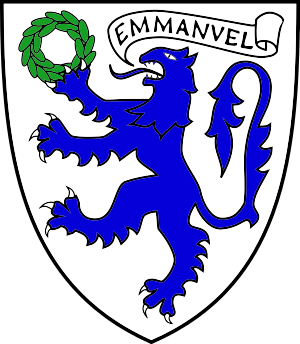
Sir Walter Mildmay was very interested in education.
- In 1583, he bought land in Cambridge for £550. This land used to be a monastery for the Dominican monks.
- In 1584, he got permission from the Queen to build Emmanuel College, Cambridge there.
The new college building was designed by Ralph Symons. It opened in 1588 with a special celebration that Mildmay attended. He set up the college with a master, three fellows (teachers/researchers), and four scholars (students). Later, more money was given, and the college grew to have fourteen fellows and fifty scholars.
A famous story says that when Mildmay met Queen Elizabeth after the college opened, she said, "Sir Walter, I hear you have built a Puritan college." Mildmay replied, "No, madam; I would never go against your laws. But I have planted an acorn, and only God knows what kind of oak it will become." This meant he hoped the college would grow and do good things.
Mildmay also supported other schools:
- He was an early governor of Chelmsford Chantry School, now King Edward VI Grammar School.
- He gave money to Christ's Hospital, a school for poor children.
- He gave money to Christ's College, Cambridge, for a Greek teacher and scholarships.
- He helped build the tower of Great St Mary's Church, Cambridge.
- He helped start a free school in Middleton, Lancashire.
There are several paintings of Sir Walter Mildmay. Three of them are at Emmanuel College.
Family Life
Mildmay married Mary Walsingham (died 1576). She was the sister of Sir Francis Walsingham, another very important person in Queen Elizabeth's government.
Sir Walter and Mary had several children, including:
- Sir Anthony Mildmay (died 1617), their oldest son, who became an ambassador to France.
- Humphrey Mildmay.
- Winifred Mildmay, who married Sir William Fitzwilliam.
- Martha Mildmay, who married Sir William Brouncker.
- Christiana Mildmay, who married Charles Barrett and later Sir John Leveson.
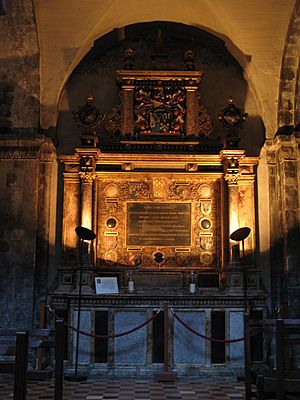
Images for kids



